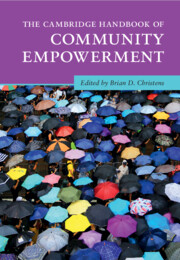Book contents
- The Cambridge Handbook of Community Empowerment
- Cambridge Handbooks in Psychology
- The Cambridge Handbook of Community Empowerment
- Copyright page
- Contents
- Figures
- Tables
- Contributors
- Building Community Power
- Part I Organizing and Activism
- Part II Participatory Governance
- Part III Civil Society and Coalitions
- 11 Community Leadership Development
- 12 Community Coalitions and Empowerment
- 13 Youth-Infused Community Coalitions
- 14 Neighborhood Associations and Community Change
- 15 State-Led Community (Dis)empowerment in China
- Part IV Enterprise
- Part V Participatory and Community Arts
- Part VI Education and Engaged Research
- Contributor Details
- Index
- References
15 - State-Led Community (Dis)empowerment in China
from Part III - Civil Society and Coalitions
Published online by Cambridge University Press: 18 April 2024
- The Cambridge Handbook of Community Empowerment
- Cambridge Handbooks in Psychology
- The Cambridge Handbook of Community Empowerment
- Copyright page
- Contents
- Figures
- Tables
- Contributors
- Building Community Power
- Part I Organizing and Activism
- Part II Participatory Governance
- Part III Civil Society and Coalitions
- 11 Community Leadership Development
- 12 Community Coalitions and Empowerment
- 13 Youth-Infused Community Coalitions
- 14 Neighborhood Associations and Community Change
- 15 State-Led Community (Dis)empowerment in China
- Part IV Enterprise
- Part V Participatory and Community Arts
- Part VI Education and Engaged Research
- Contributor Details
- Index
- References
Summary
The Chinese government launched a nationwide policy campaign regarding neighborhood governance in the early 2010s. The state-led movement served both to strengthen state legitimacy and enhance community development. But how it contributed to community empowerment or disempowerment is little examined. This chapter attempts to review the extant literature on the campaign from a community empowerment perspective. Implications and suggestions for future research are also included.
Keywords
- Type
- Chapter
- Information
- The Cambridge Handbook of Community Empowerment , pp. 389 - 412Publisher: Cambridge University PressPrint publication year: 2024



